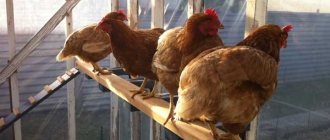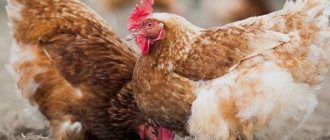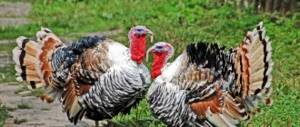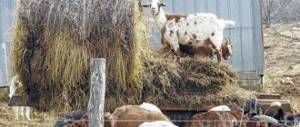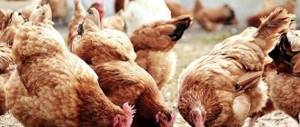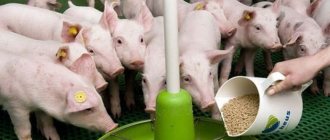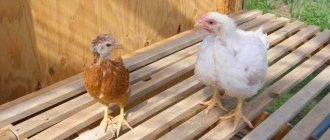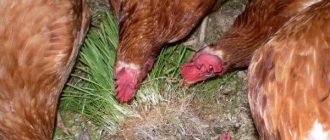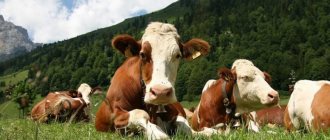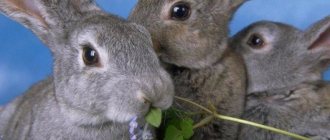Feeding ration and housing conditions for breeding bulls
FEEDING OF BULLS
The load per bull with free mating is 40-50 cows, with manual mating - 100-150, with artificial insemination, 1000-3000 cows are inseminated with the sperm of one bull, and 5000 or more cows with the sperm of the best bulls. The “responsibility” is great, so the best feeding and housing conditions should be created for breeding bulls.
Feeding of breeding bulls is organized depending on their live weight and intensity of use - in the non-breeding period, at an average load, at an increased load. Increased sexual load for adult bulls is considered to be two doublet cages per week.
Breeding bulls per 100 kg of live weight should be given 0.8-1.10 ECU during the non-breeding period, at an average load - 0.9-1.3 and at increased load - 1.1-1.6 ECU. The optimal level of digestible protein in diets: in the non-breeding period - 90 g, with an average load - 110 and with an increased load - 125 g per 1 ECU. Important indicators for the qualitative assessment of protein nutrition of stud bulls are the content of rumen-degradable (RP) and non-degradable (NRP) protein in the diet. The ratio of these protein fractions in the diet changes due to the intensity of use of stud bulls - from 60-65: 40-35 in the non-breeding period, to 40-50: 60-50 with increased load. For any amount of protein, the optimal sugar-protein ratio should be in the range of 0.8-1.0:1. It should be remembered that carbohydrate feed, along with improving the digestion and sexual activity of bulls, leads to obesity and their retirement as producers. Feeding standards for adult bulls are developed depending on their live weight and intensity of use (see Tables 41-43).
For breeding bulls with insufficient body condition, the feeding rate is increased at the rate of 1.1 ECU and 120 g of digestible protein for every 200 g of planned average daily gain.
To constantly maintain a “working” form, you should adhere to the following structure of diets (in % nutritional value):
1. In winter: hay - 25-40%, concentrates - 40-50 and succulent feed - 25-30%.
2. In summer: hay—15-20%, concentrates—35-45 and grass—35-40%.
Feed used in feeding bulls must be of class I quality. It is not practiced to feed bulls waste from technical production: pulp, stillage, pulp, brewer's grain, cake and cruciferous meal (rapeseed, cotton). A sudden change in the composition of the diet is also undesirable, as this disrupts the formation of sperm and reduces its quality.
With a sufficient range of high-quality plant feeds (silage, haylage, hay, fodder or sugar beets, carrots, concentrates), there is no need to introduce feed of animal origin into bull diets.
Table 41
Feeding standards for stud bulls during the non-breeding period
Table 42
Feeding standards for stud bulls at an average load (one doublet cage per week) per head per day
Table 43
Feeding standards for stud bulls under increased load (2-3 doublet cages per week), per head per day
Table 44
Approximate rations for breeding bulls under increased load, per head per day
Examples of the diet of stud bulls under increased load are presented in Table. 44.
With insufficiently complete plant diets and with increased sexual load (2-3 doublet cages per week) in winter, the inclusion of animal feed, as well as vitamins and minerals in the diets of bulls, has a beneficial effect on sperm quality. In such conditions, it is advisable to include blood, fish, meat and bone meal, skimmed milk powder (from 50 to 400 g per day) and chicken eggs (3-5 pieces) in the diet.
During the summer, bulls should receive a moderate amount of green feed. In this case, it is advisable to feed up to 50% of the green feed in the form of dried grass or hay. Feeding excessive amounts of green feed is often the cause of reduced sexual activity in bulls.
The real and optimal form is individual feeding of bulls three times a day. Usually the daily amount of concentrates or mixed feed is divided into three cottages; the main amount of succulent feed (70-80%) is fed during the day. It is best to feed bulls after semen collection or mating. Animals are given water from automatic watering stations. If they are not available, bulls should receive water at least 3 times a day.
Feeding calves for fattening: diet
Small and proper nutrition is the key to health and rapid weight gain for all ruminants. There are a huge number of feeding schemes and principles that allow you to get the effect of rapid weight gain in an optimal period of time.
Proper feeding of fattening bulls should pursue two goals:
- Development of rumen digestion.
- Effective weight gain.
The farmer is free to independently select the diet for keeping bulls based on his capabilities. However, you should adhere to certain rules for selecting nutrition depending on the age category of the young animals.
In the first month of life, the main food for calves is colostrum in the amount of 8-10 liters per day, adding 5 g of table salt and phosphate fertilizer from the tenth day. Starting from the twentieth day, grain supplements from steamed barley or oatmeal are added to the calf's diet. The daily norm is 100 g.
Second month
Keeping bull calves at home involves supplementing the diet with hay in the amount of 200 g. To gain weight, increase the daily rate of grain supplements to 200 g. The amount of table salt in colostrum must be increased to 10 g, and phosphate supplements to 15 g. Starting from the fortieth day, use a scheme for dividing the daily milk intake into equal parts of whole milk and skimmed milk. At the 7th week of life, the daily intake of hay is increased to 500 g, grain mixture to 700 g.
In the third month, the young animals are completely converted to 10 l/day, the amount of concentrates is increased to 1 kg, and potatoes are introduced in the amount of 200 g/day. Starting from day 70, fattening bulls in a quick way involves increasing the daily potato intake to 300 g of roughage to 900 g, concentrated feed to 1.4 kg. At the end of the third month, the calf should receive 1 kg of hay, 0.5 kg of potatoes, 1.6 kg of steamed grain mixture per day.
Fourth month
From this moment, the amount of skim milk decreases to 8 liters, but the amount of roughage increases to 1.2 kg. The daily norm of root vegetables and concentrates is already 1.5 kg. In the middle of the fourth month, silage in the amount of 0.5 kg is introduced into the diet of the bulls. At the end of this period, each calf should receive 1.5 kg of roughage, 1.6 kg of grain mixture, 1 kg of silage.
Read more: Artificial insemination of pigs at home: preparation, selection of sows, insemination technique
Fifth month
The most effective diet for fattening bulls in the fifth month is to obtain the daily norm of the following products: 8 liters of skim milk; 1 kg of silage and root crops; 1.8 kg of concentrates in the form of a mash. At the end of the month, the norm of plant food is increased to 2 kg per day. The milk intake is reduced to 4 liters.
Sixth month
Fattening calves for meat by this time involves a gradual cessation of milk consumption.
To receive adequate nutrition, a young bull must receive:
- 2.5 kg of plant food;
- 3 kg silage;
- 1 kg of potatoes;
- 2 kg of concentrated feed.
The daily salt intake is 20 g; phosphates – 25 g. At the end of the sixth month, milk is completely removed from the diet. The hay norm is 3 kg. The amount of silage increases to 5-6 kg/day.
A properly selected diet during the dairy period is the most important for the formation in the intestines of the necessary amount of enzymes for good digestion. Beginning livestock breeders often ask what to feed calves for rapid growth during the life period from 6 months to 1 year. The diet of calves placed for fattening is formed depending on the availability of a certain feed base and the selected type of feeding. Consumption rates are designed to increase muscle mass by 700-800 g per day.
There are three types of feeding:
- Senazhny. Includes daily consumption of 1.5 kg of fresh hay, 8 kg of haylage, 2 kg of concentrated feed (KR-1). The daily norm of table salt is 20 g; phosphate fertilizing – 35-40 g.
- The silage and haylage diet includes: 10 kg of silage (preferably corn); 2 kg of fresh hay; 4 kg of haylage; 2 kg of concentrated feed. The daily intake of salt and phosphates is 20 and 40 g, respectively. On average, daily weight gain on this diet is 0.8 kg.
- A combined diet involves the use of silage, hay and root crops for feeding calves: potatoes, sugar beets, pumpkins, zucchini, carrots. The daily ration for a bull is: 5 kg of hay and root crops; 8 kg of silage, 3 kg of concentrates. Consumption of salt and phosphates is 20 and 40 g, respectively.
By the end of this period, the weight of a one-year-old bull can reach 320-400 kg.
For livestock breeders, this period of time is called the growing period. Depending on the type of feeding chosen, a young bull should receive a certain amount of products that will help gain muscle mass up to 600-700 kg.
Diet of bulls:
- The haylage type of feeding involves daily consumption of 10 kg of haylage, 2 kg of hay and concentrated feed.
- The silage and haylage diet includes: 14 kg of silage, 5 kg of hay and 2 kg of concentrated feed.
- The combined feeding ration for a bull is: 10 kg of silage, 5 kg of haylage, 3 kg of fresh hay, 6 kg of root crops.
For any feeding ration during this period, the daily intake of minerals is: table salt - 40 g, phosphate supplements - 50 g.
How much hay does a bull need for the winter? The winter nutritional structure involves consuming 45–50% of hay from the total daily diet.
For the first six months, the basis of the calf’s diet is milk. The main task of this period is to correctly transfer the diet from a milk diet to fattening. In the first month, the calf consumes 8 to 12 liters of milk per day. From the 10th day you need to mix phosphorus (5 g per 1 l) and salt (10 g per 1 l) into the milk.
At two months of age, 200 g of grain, the same amount of hay and root vegetables are added to the daily diet. Instead of grain, you can give steamed porridge. Eating silage at this age is not advisable. The amount of milk is gradually reduced to 4-6 liters per day. The amount of phosphate and salt is doubled.
The first six months of the calf's diet is based on milk.
In the 3rd and 4th months, boiled potatoes are introduced into the diet. The amount of milk remains the same. Towards the end of the period, you can give calves silage (no more than 0.5 kg per day). Any variety will do, but it is better to use corn.
Refusal of milk occurs within 5 months. During this time, silage consumption increases to 20 kg per day. The diet should be increased gradually, 1-2 kg per day, so as not to spoil the animal’s digestive system.
If the animal requires more food, then the portions can be increased by 1.5-2 times a day for 2-3 days in a row. This will be enough for the portions to catch up with the development of the individual, which exceeds the norm.
From 6 to 12 months, the main gain of muscle mass occurs. With the right diet, ordinary calves at this time gain 500-800 g per day.
The weight gain of purebred individuals can reach 1.5 kg. For full development at this age, an animal requires 1.5 kg of hay, 10 kg of straw, 2 kg of feed. This is subject to rearing in stalls. For pasture cows, 7 kg of hay and 2-3 kg of concentrates are distributed for 3-4 meals.
50 g of salt and 40 g of phosphates are used as additives. To be completely sure that the animal is consuming the supplements, they are dissolved in a drinking bowl, which is installed in the stall at night.
Another option: mixing additives with feed. But not every animal will eat such food. In water, the calf will not feel the additive.
Read more: The largest bull in the world, record holders: photo, video review
At this age, the amount of silage used doubles. You can reduce your hay consumption by 1-2 kg and add haylage to your diet.
The main thing is to monitor the presence of grass in the pasture or the amount of silage in the feeder. If animals are eating too quickly, this will be visible at the feeders and the ration should be increased by adding more hay or grains.
Fattening bulls must begin from the first days of life. In order for calves to immediately gain weight, it is better to leave them suckling on their mother’s milk. But you can dilute the diet with porridge, bread, whey and grain steamed in boiling water. It is better to choose oats, as they are well digestible and have a sufficient amount of vitamins and microelements.
Feeders for fattening small bulls can be filled several times a day, but not less than three, while maintaining equal intervals between feeding food. The most active feeding of calves is considered to be the first three months after birth. The gain per day is about one kilogram. To sell large-weight one-year-old calves, they should continue to be fed intensively for up to 12 months.
Maintenance and feeding of bulls
What are breeding bulls? In short, they are machines for producing sperm suitable for fertilizing breeding stock. Its health, longevity and ability to perform its functions directly depend on the conditions of detention and feeding regime. If the maintenance regime does not meet the needs of the animal, and feeding is carried out without due attention, then this situation can cause deterioration in health and a reduction in the period of suitability for fertilization. Proper maintenance and use of a balanced diet will make it possible to use the animal’s capabilities to the fullest.
Producing bulls do not require separate barns or areas for their maintenance. In a common barnyard, it is sufficient to allocate a separate stall with a feeding compartment. The only limitation for the fertilizer is a strap of sufficient strength in the event of a sudden jerk by the animal. The strap must be attached to the collar. You should never tie a beech tree by its horn or nose ring.
Bulls must be constantly loaded with light work. A harness is required to determine the load for the bull. If the bull is not overloaded with work, and walking and walking are limited, the animal will eventually become fat and acquire signs of an angry character. As a result, refusal to carry out mating.
Evaluation of breeding animals
Evaluation of breeding bulls by pedigree can only be approximately approximate. A more reliable way is to analyze the offspring. The task of assessing insemination bulls is to identify the most valuable individuals in breeding terms, which have high productivity and can produce high-quality offspring.
Read also: How to age wood
To evaluate a sire based on offspring, certain requirements must be met. The characteristics of the offspring depend on both the heredity of the father and mother. Uterine development is inextricably linked with the maternal body. Even the conditions under which cattle are kept have an impact on calves.
The uterine composition of a cow is also important during mating. The sire should be mated with those queens with whom the breeding use of this inseminator is still being considered. Another condition that affects the manufacturer’s assessment is the age of the parents at the time of mating.
A young producer conveys his productivity worse. For mating, it is better to choose a male who is in the phase of full development. Evaluation is given not only to productivity indicators, but also to product quality. Therefore, the value of a bull depends on the following conditions:
- careful selection of mothers;
- taking into account the age of parents;
- offspring requirements for living conditions;
- assessment of calves based on biological and economic qualities;
- study of the results of each mating.
Milk productivity is assessed by the volume of milk produced during the lactation period and the productivity of the cow throughout its life. Artificial insemination significantly affects the increase in milk productivity of future heifers.
Keeping a bull
When the bull reaches the age of one and 2-3 months, a ring is inserted into his nose. To prevent splitting of the hooves, they are constantly cleaned, as well as various disinfectant and preventive actions.
The keeping of sire bulls can be differentiated by time of year. So, during the cold period, bulls are transferred to insulated barns with ventilation, good floors and stalls. The bulls must be positioned so that their faces are facing the wall. A leash is required for each individual. The length of the leash should be sufficient for the animal to lie down if necessary.
During the cold season, it is necessary to provide for and be sure to walk the animals with a light load. In some farms they make a special chaise for harnessing the bulls of the producers, in others they organize a special pen for walking the bulls in a circle. During events, bulls should never be allowed to come into contact with each other, as they can injure each other.
In the warm season, it is best to organize walking on pastures with good grass. At the same time, there must be a place for the animals to hide in the shade. Up to the construction of special canopies.
Feeding bulls
A normalized feeding schedule for a bull will make it possible to use the animal’s seed potential as efficiently as possible. Rational nutrition is the key to excellent seed formation in a sire. To obtain maximum performance, a bull’s diet must contain mixtures of cereals and legumes in a ground state, with the obligatory presence of solid feed in the form of hay. Concentrates are given in a mixed state. Be sure to include proteins and others in your diet. If a deficiency of vitamins is detected, it is necessary to use dietary supplements; sometimes fish oil is added to the diet. Before doing this, be sure to consult with your veterinarian.
The diet is compiled with a clear account of all the parameters of the animal and the use of an individual approach, taking into account the breeding indicator. For calves that have not reached puberty, as a rule, nutrition is oriented towards maximum weight gain, that is, as plentiful as possible.
Mature males begin to be limited and the full development of the male is constantly monitored with the current diet. Sexually mature males, during the period when mating does not take place, are transferred to a limited diet. All stages of feeding are carried out according to schedule without the slightest deviation.
It is also recommended to feed bulls with various microelements to prevent diseases. In this case, it is imperative to follow the schedule. Otherwise, there is a threat of losing the manufacturer.
Diet and nutritional rules for the inseminating bull
The inseminating bull plays the most important role in the systematic development of a cattle breeding farm. Feeding the inseminating bull has a number of features.
A harmonious diet increases libido and improves sperm quality. The volume of feed depends on the weight of the male and the breeding load. In winter and early spring, you need to increase the amount of vitamins and minerals.
Features of feeding
The food consumed by bulls, the frequency of feeding, and the composition of products directly affect the quality of their seed production and sperm production. Even if the gene pool suggests high rates of reproductive functions, unbalanced or low-quality food can reduce them. Restoration of germ cells after a failure occurs only after two months. When keeping stud bulls, it is important to consider the energy balance of food. At rest, they require less feed energy than when under load.
Advice! It is important to maintain a balance of food units during the formation of the male genital organs.
Just as a lack of feed negatively affects the productivity of a bull, overfeeding leads to a decrease in sexual functions due to the obesity of the animal. The manufacturer differs from other categories in its more intense protein metabolism, which increases their protein requirement. A deficiency or excess of this component entails serious violations, even changing the gene pool of cattle.
Feeding of the bulls begins at six in the morning. They are given only high-quality and nutritious foods. The diet usually consists of hay, haylage, straw, chaff, bagasse, stillage and brewer's grains. Cotton and cruciferous crops cannot be used for feeding. To satisfy their energy potential, bulls are fed sugar and salt, which are given along with feed or in separate briquettes. At a large breeding station, technologies are used for individual feeding of each individual, which makes it possible to take into account all the factors affecting the bull of the producer and to compensate for the lack of any substances in the body.
Features of the diet of inseminators
When it comes to cattle producers, their breeding value plays a major role.
It characterizes the genetic potential of a bull, its ability to produce offspring of suitable economic quality. From such individuals cows are born that have high milk productivity. The offspring hereditarily has good external characteristics and health. The normal development of qualities is influenced by feeding.
Proper care is needed for breeding males. A balanced diet is designed to increase sexual desire, activity, quantity and quality of ejaculate. Also, reasonable feeding will help keep bulls healthy and use them longer to produce offspring.
Excessive amounts of feed also have a bad effect on producers, just like insufficient amounts: bulls begin to get fat, and the photo shows that it is the inseminators who are distinguished by their large growth. Obesity reduces libido, males do not engage in mating. Their behavior may become aggressive. The quality of sperm becomes worse.
When compiling the inseminator’s diet, the following parameters are taken into account:
- age;
- breeding load;
- number of days of rest;
- body weight.
The manufacturer must obtain sufficient amounts of protein. This is the most important component of the diet. It forms muscle mass and affects the composition of the seed. A healthy adult male cattle must be large, tall, with a broad chest and minimal fat mass. Vitamins and minerals also have a significant impact on male health. Vitamin A plays the greatest role: it is involved in the regulation of the activity of the gonads in cattle.
Basic rules for selecting sire bulls
The selection of bulls is carried out in two directions: the first is lines, the second is families.
The essence of these directions is as follows:
- Lines. Only the best bulls, called studs, are used.
- Families. Queens with the highest indicators are selected and families are created from them.
Read also: Mating cows with bulls
The main selection criteria for lines are:
- quality of offspring. This is also checked when the animal turns one year old. Two to three dozen cows are inseminated with bull ejaculate. If more than half of the cows are fertilized, the bull has passed the selection. The milking “daughters” of a bull are assessed for quality when they are one to one and a half years old. The breeding value of a producer is determined by the difference in the productivity indicators of his “daughters” (milk yield should exceed the norm by 180%) and their other yearlings.
How to feed young bulls
Stud bulls can be obtained from the mating of a cow and a male with high breeding value. The right diet will help you raise a strong, beautiful, healthy and active male.
A calf up to one year of age must actively gain weight (up to 1 kg per day), so the animals are fed generously. By the age of 12 months, the body weight of the bull will be up to 330-360 kg. Proper nutrition of young males will ensure good productivity in the future.
After reaching the age of one year, the bulls begin to be fed moderately. A proper diet ensures normal development of the gonads and accelerates the onset of maturity. You can collect ejaculate from a healthy young bull and assess the quality of future breeding offspring. The breeding value must be at a high level. The sperm of such an animal is used to inseminate cows.
Harmonious nutrition for bulls over one year old weighing 330-360 kg:
- Green food. The basis of the diet is hay from grass, cereals and legumes. The food must have good taste.
- Compound feed with a simple composition. Feed components - grain (corn or oatmeal), a product with a high protein content (meal, dry skim milk).
If necessary, vitamins A, D and mineral supplements (table salt, phosphates) are added to the feed. The bulls need to be given clean water to drink. Proper care will allow you to raise a productive breeding bull.
Males begin to inseminate cows at 1.5 years of age; the breeding load is constantly growing and becomes maximum when the bull reaches three years of age.
Raising bulls
Young animals are fed well so that they gain a kilogram every day until they reach one year of age. At twelve months, a bull should weigh about three hundred and eighty kilos.
Growing up entails eating more moderately. This approach promotes competent growth, sexual maturity, development of the testes and maintenance of the desired weight.
- The main food for twelve-month-old bulls is cereal-legume hay, preferably green.
- Simple combined feeds with one grain component are selected. It can be corn or oats, or meal or dry skimmed milk.
- Excess weight is considered a disease; excess nutritional supplements do not increase sperm count. It only makes animals lazy.
Rated feeding of stud bulls should take into account changes in weight every month. To do this, they keep a diary in which they record information about fatness, coat, legs, and the condition of the hooves. Agility, signs of aggression or calmness and appetite are important.
Regardless of the time of year, the nutrition of bulls must be of high quality and complete in order to supply sperm according to the farm plan. At the same time, the digestive system, when receiving biologically balanced diets, should work like a clock.
About two months before the first mating with a cow, it is not recommended to give silage and beets to males. And when a new breeding period begins, chicken eggs, fish and blood meal, yeast, and sprouted grain appear on the menu.
An approximate daily routine provides feeding standards for stud bulls:
- At about four o'clock the dispensing of water begins, then feeding with concentrates and roughage. Manure is cleared from the stall. The animal rests for a couple of hours;
- in the morning, from seven to ten, walking, mating, and cleaning of the pen are possible;
- in the interval from ten to thirteen, the bull is watered and fed juicy and rough food. Then rest again until sixteen hours;
- up to nineteen hours of exercise, work, mating;
- in the evening, dispensing liquids, concentrates, roughage, cleaning out manure and dirt.
The preferred food for breeding bulls is hay made from perennial cereal grasses, which were harvested in the heading phase, and legumes, mowed in the first days of flowering. For mowing, choose foxtail, timothy, fescue, and bluegrass. During the grazing period, grass is given thirty days after it is harvested. It should be a little wilted.
More on the topic: Approximate diet of the Charolais cow breed
Among the feedstuffs, a third should be oats, more than twenty percent wheat bran, sixteen percent barley, five percent wheat, sunflower cake - ten, feed yeast - three, skim milk powder - five, premixes and salt - one each.
After the completion of the stall period, vitamins are given in the form of preparations twice a week along with the combined feed.
How to feed adult stud bulls
The diet of a breeding bull needs to be adjusted every month. It is important to consider the following factors:
- live weight;
- fatness;
- appearance of the hairline;
- condition of the front and hind legs;
- quality of glaze on hooves;
- behavior towards other animals and humans;
- evenness when standing, ease and speed of walking;
- interest in food.
If the inseminator has noticeably gained weight, his gait is heavy, his legs become weak. These are clear signs of the onset of obesity. The feeding intensity should be reduced. Loss of appetite may indicate vitamin deficiency or problems with the gastrointestinal tract.
A sire should receive an equally rich diet all year round so that the breeding load on him does not decrease. In winter and early spring, hay loses nutritional value and vitamins, so nutritional supplements are purchased for this time of year. Vitamin deficiency in a bull will lead to impaired sexual function and decreased sperm quality.
The inseminator needs 2 or 3 meals a day. Feeding is carried out from a separate feeder. In the morning, a large bull producer is required to eat half of the daily amount of feed, 1.5-3 kg of hay. When the seminal fluid is collected, the bull is fed exclusively with mixed feed in the morning. Hay is given after collecting biomaterial
The impact of nickname on performance
The names of bulls can be very different; a very large number of them have already been invented. There is an opinion that names influence not only the character of the animal, but also its performance. For example, when raising a strong, strong and healthy bull, you should not give him diminutive nicknames.
At bull breeding enterprises, a clear record of each individual is kept, and calves are given nicknames in accordance with the first letter of the parents’ names. Heifers receive their letter from their mother’s name, and males receive their letter from the sire’s bull, that is, their father. In small farms, young animals are simply called by the word they like.
Advice! Giving human names is considered an incorrect action in relation to the Orthodox faith, which determines the patronage of saints in connection with the name.
It is recommended that the nicknames of breeding bulls be short, but pleasant to the ear, since these animals do not tolerate rudeness. With a large herd, the names must be distinguishable so that the nickname of each individual cattle can be remembered.
Breeding bulls is an integral part of livestock farming. The offspring of cattle as a whole depends on the correct implementation of all care rules. A healthy father increases the chances of having calves like himself. The productivity of a bull can be determined both in the early stages of development, by taking tests, and by assessing its offspring. By receiving rationed and balanced feed, as well as the necessary housing conditions, the bull is able to consistently produce high-quality sperm.
What to feed stud bulls
The vitamin and mineral composition of feed should remain constant throughout the year. Bulls need to be fed using the following components:
- Green hay. They use hay from legumes and cereal grasses. If the weight of a bull is 600 kg, he is given 10 kg of grass per day, 800 kg - 11 kg of grass, 1 t - 13 kg of grass.
- Combined feed. Consists of a mixture of: oats (35%), wheat bran (24%), wheat grain (5%), barley (16%), sunflower cake (10%), yeast (3%), admixture of skim milk powder (5% ), table salt (1%). A bull weighing 600 kg is given 2.8 kg of feed, 800 kg - 2.9 kg, the largest bull weighing 1000 kg should receive 3 kg of feed.
- Animal product. Mix with frequent use of the bull (insemination 2-3 times a week). Meat and bone meal, fish meal, chicken eggs, etc. are used.
The inseminator needs 2 or 3 meals a day. Feeding is carried out from a separate feeder. In the morning, a large inseminating bull should eat half of the daily amount of feed, 1.5-3 kg of hay. When the seminal fluid is collected, the bull is fed exclusively with mixed feed in the morning. Hay is given after collecting biomaterial
Diet of bulls in winter and early spring
In summer and autumn, green hay contains enough vitamins. In winter, bulls may lack vitamins, so the diet of the inseminators is adjusted. Supplements with vitamins A, E and D are mixed into the feed.
Vitamin standards for livestock must be indicated on the packages. Mineral substances used include sodium chloride (kitchen salt) and feed phosphate. You also need to increase the amount of protein in the diet, this is also important for the cow. It is advisable to add 50-400 g of skimmed milk powder to the food daily, 4-5 pcs. chicken eggs, blood or bone meal, 2-3 liters of skim milk. A rich diet during the winter season can maintain high levels of sperm production.
The most effective fattening of bulls: diet and nutrition plan
Few farmers, especially those who are just starting to breed cattle, know how to feed young bulls from one year old, how much food they should receive and what feeding method to use in order to quickly increase their weight.
Approximate composition of daily feeding:
- three kilograms of hay;
- four kilograms of root vegetables;
- one and a half kilograms of concentrated additives.
In summer, the main food of young bulls is pasture, and in winter, to quickly fatten growing animals, they use hay, fodder root crops and compound feed. Food can be varied with oil cake and flax. Some farm managers fed one-year-old calves with boiled and chopped potatoes, as well as food waste.
A big advantage for the farm will be its location close to processing plants. At bakeries, distilleries and other industries, you can get good complementary food for cattle. If you know how to fatten livestock for meat purposes, determine the appropriate method and correctly draw up nutritional plans, then by the age of one and a half years the young animals increase their weight tenfold.
Newborn calves are more demanding to maintain; they need special care and feeding with mother's milk. Therefore, it is better to purchase four-month-old individuals with a body weight of at least one hundred kilograms.
Holstein, Hereford, Kalmyk bulls, as well as other meat breeds, are capable of producing rapid gains at low cost of fattening. They were specially bred for growing for meat purposes and are unpretentious to living conditions and climate.
Many people prefer to eat delicacy beef; it can be stored frozen without loss of vitamins and other elements necessary for the human body. Marbled meat is valued by gourmets and is served in restaurants. The purchase price of such a product is quite high, which is why breeding bulls as a business has recently become popular.
You need to choose a bull after several months of life, because the process of gaining weight needs to be started as early as possible. Attention is paid to the legs and neck of the animal.
Healthy individuals already stand firmly on their feet at an early age, turning their necks in search of a cow. They are constantly looking for their portion of milk. This behavior indicates a strong neck and bones.
Read more: Chrysanthemums, autumn flowers in the garden, planting and late care
You need to choose a bull after several months of life
If the bull is not selected from the annual offspring and is purchased only for fattening, then the best month for purchase will be March or April. At this time, animals that were born in winter or late autumn are sold. Such bulls have a strong immune system and are better able to tolerate illness and stay in a stall.
If possible, then you need to take individuals of a certain breed. For such an animal you will have to go to a factory where they produce specific breeds.
Despite the inconvenience, such a purchase provides certain guarantees: the breeder provides a passport of the animal, which confirms its origin and the advantages of the breed. In any other place there is still a possibility of buying a bull of poor quality.
Basics of keeping bulls and rules for feeding them
Cattle breeding attracts attention not only as an interesting area of farming, but also as a potentially profitable area of business. In particular, bull breeding can be considered one of the most promising types of livestock farming. Given the current high level of prices for beef meat, such activities can not only satisfy the personal needs of the farmer, but also represent a profitable business.
Breeding bulls is a profitable business
However, like any serious matter, breeding bulls at home requires careful practical training and certain theoretical knowledge, because animals need a properly organized regime, keeping in specially prepared places, and high-quality nutrition.
Features of keeping on a farm
There are specifics to breeding bulls at home. First, you need to decide on the space for the stall. It should be moderately lit, warm, and equipped with partitions to provide the animals with personal space. The premises for keeping bulls must comply with basic safety standards.
You should choose the right harness. If you use a thin rope for bulls, then with a high degree of probability they will easily break it. Even at home, it is optimal to use a strong chain with rings welded together. The bull must be tied both tightly and loosely at the same time, so that the tether does not interfere with movement and does not squeeze the animal’s neck, and a piece of durable fabric or leather must be placed directly under the collar to avoid excessive friction against the metal.
A grown bull cannot be kept without a leash
Properly organized housing of bulls also implies high-quality hygienic care. It is advisable to brush the cattle daily with a brush, and in the warm season wash them in the shower or in reservoirs with running water. The extent of hoof horn regrowth should be monitored and the hoof should be cleaned and trimmed at least twice a year during the off-season.
For the safety of the owner and caring staff, as well as for the convenience of working with the animal, a nose ring should be installed when the bull reaches the age of twelve months.
In barnyard conditions on farms, it is permissible to keep bulls together with cows. This makes their temperament more calm. In general, when raising bulls, you should pay attention to the type of their nervous system. Animals that are overly aggressive, excitable or too shy are usually culled, because keeping such animals may be unsafe.
It is acceptable to keep young bulls with cows
Maintenance and use of breeding sires
Premises for keeping stud bulls (general view)
A typical room with breeding bulls that meets sanitary and hygienic requirements and a favorable microclimate.
Decreased sexual activity, deterioration in sperm quality, manifestation of masturbation, weakening and disease of the limbs are primarily a consequence of violations of the maintenance and use of bulls.
Recommended microclimate parameters in bull farms
| Indicators | Winter period | Transition period |
| Air temperature, °C | 8 (5-15) | 12 (8-20) |
| Relative humidity, % | 75 (40-85) | 75 (40-85) |
| Air exchange per head, m3/h | 100 (80-250) | 250 (110-350) |
| Content: carbon dioxide, % | 0,20-0,25 | 0,20-0,25 |
| ammonia, mg/m3 | 10 | 10 |
| hydrogen sulfide, mg/m3 | 5 | 5 |
Stud bull in a stall on a chain leash with a thick belt collar and nose ring (stall length 2.5 m, width 1.8-2 m)
Lack of air exchange reduces sperm production in bulls by 15-20%. The most important condition for long-term health and reproductive ability of the producer is daily active exercise. Exercise and active walking increase semen levels by 10-20%.
Sire bulls on pasture to ensure active exercise
Summer camp for bull sires that meets modern requirements
Stud bulls on a walk
Insolation of breeding bulls in early spring allows you to meet the body's vitamin D needs
Ring corridor with a perimeter of 120-150 m for active exercise of breeding bulls
Bulls must be brushed regularly, and in the summer, when the air temperature is 20ºC and above, they must be washed in the shower or bathed in a flowing pond, protected from access by outside animals.
For each manufacturer there should be a separate hair brush with a nickname or number written on it.
On the eve of semen collection, bulls are washed in the shower with warm water using detergents (soap, soap alcohol, etc.). Before collecting sperm, the prepurcial opening and adjacent areas of the abdomen are thoroughly cleaned. The length of the hair tuft at the prepuce, which is almost always dirty, should be at least 2 cm, taking into account its protective role. Hair cut too short can cause irritation to the preputial mucosa.
Before bringing a bull out of the stall to obtain semen, the stockman must ensure that the animal is clean and ensure that there is no residue of contaminated bedding or feed on the bull's fur or hooves.
Attention! Improper preparation of the bull reduces the quality of the ejaculate obtained (increases the likelihood of its contamination during collection).
Customized Bull Cleaning Tools
Washing the stud bull
Sire bulls prepared for semen collection
The hooves of stud bulls are trimmed and trimmed as they grow, having previously secured the bull in the machine to ensure the safety of personnel during work.
Machine for fixing stud bulls Fixing stud bulls for hoof processing
Fixing a bull's leg (close-up) Cleaning the hooves with a hoof knife
Treatment of the hoof with an electric tool (grinder)
Treating the hoof with a disinfectant solution. Bandaging the treated hoof.
Attention! Improperly processed hoof horn causes pain and lameness; this can cause refusal to mount or inhibition of the conditioned reflex, which negatively affects the quality of the emitted seed.
To ensure the safety of the handlers, all bulls are given a nose ring from 9 months of age. It should be tightened with a forehead strap so that it does not interfere with eating food. You cannot tie an animal by its nose ring.
Nose ring (general plan) Inserted ring
Opened nose ring General view of the carrier stick
The sire should be led in a halter using a stick-carrier about 2 m long with a carabiner controlled from the handle of the stick, which is hooked onto the nose ring.
The use of bulls begins at 10-12 months of age. Up to 18 months, take one ejaculate per week. From 18 to 36 months, sperm is taken 3 times every two weeks - in a doublet. Producers over three years old are used 3 times every two weeks and sperm are taken in triplet. The interval between sperm collections should be at least 12 minutes. At this time, the bulls are driven in a circle for 12-15 minutes. Rare use of bulls causes the attenuation of conditioned reflexes.
Feeding and caring for the bulls follows a special daily routine. When creating a daily routine, you must remember that semen collection is allowed no earlier than 2 hours after feeding and watering.
Rules for walking bulls
For safety reasons, bulls are allowed to walk only with the use of special tools (leash and stick). There should be no people or animals on the road that the bulls will follow, as the bulls can be quite aggressive. It is advisable to use special ranges as places for walking animals. Good physical activity while walking will allow the animal to relieve aggression and tension.
Daily exercise for bulls may include the following types of activity:
- working in harness for several hours;
- free range in pens;
- in the presence of special equipment - forced wiring.
Keeping bulls is inextricably linked with feeding, because without good nutrition the animal will not be able to grow healthy and strong.
Bulls need regular walks in the fresh air
Organization of feeding bulls
When organizing feeding for bulls at home, it is necessary to correctly select the composition and quality of feed, feeding regimen and technology.
Young bulls one year of age or less should be fed generously to ensure good average daily weight gain.
As animals age, it is advisable to switch to more moderate feeding. This regime will ensure full development and growth, eliminating the possibility of obesity.
When should you change your diet?
The diet and nutritional standards of each bull should be adjusted monthly, taking into account its weight; for this, it is necessary to periodically evaluate the fatness, appetite and weight of the animals, as well as the condition of the skin and coat, the evenness and smoothness of the hoof horn, the condition of the limbs in general, behavioral characteristics, etc. It is recommended to keep statistics not only in large farms, but also when breeding animals at home. When the first signs of obesity occur, feeding rates should be reduced.
When fattening bulls, obesity should not be allowed
There are certain specific features of the organization of feeding bulls with a difficult disposition. Such animals can be aggressive, so the person caring for them needs to be careful.
For example, you should not turn your back on an aggressive bull, and during feeding you should keep your distance as much as possible.
When feeding bulls, especially at home, the quality of the feed should be carefully checked, because the food must be safe, have high nutritional value and satisfy the need for vitamins and microelements.
The feeding of sire bulls is particularly specific. Organizing the nutrition of such animals and their maintenance requires strict adherence to the daily routine.
